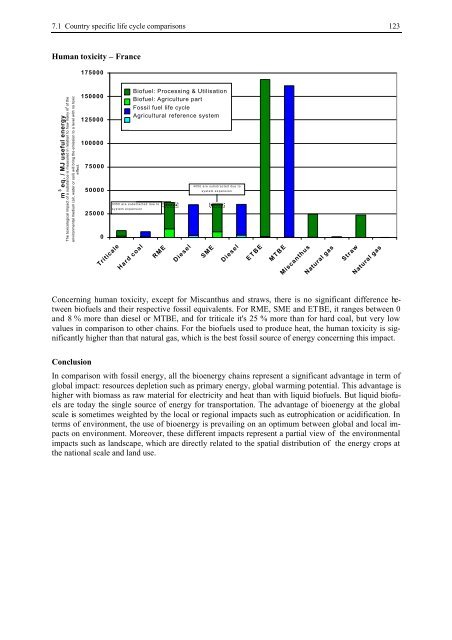BIOENERGY FOR EUROPE: WHICH ONES FIT BEST?
BIOENERGY FOR EUROPE: WHICH ONES FIT BEST?
BIOENERGY FOR EUROPE: WHICH ONES FIT BEST?
You also want an ePaper? Increase the reach of your titles
YUMPU automatically turns print PDFs into web optimized ePapers that Google loves.
7.1 Country specific life cycle comparisons 123<br />
Human toxicity – France<br />
m 3 eq. / MJ useful energy<br />
The toxicological impact of a substance is measured in relation to how many m 3 of the<br />
environmental medium (air, water or soil) will bring the emission to a level with no toxic<br />
effect.<br />
175000<br />
150000<br />
125000<br />
100000<br />
75000<br />
50000<br />
25000<br />
0<br />
Triticale<br />
3350 are substracted due to<br />
system expansion<br />
Biofuel: Processing & Utilisation<br />
Biofuel: Agriculture part<br />
Fossil fuel life cycle<br />
Agricultural reference system<br />
Hard coal<br />
RME<br />
Diesel<br />
4050 are substracted due to<br />
system expansion<br />
SME<br />
Diesel<br />
ETBE<br />
MTBE<br />
Miscanthus<br />
Natural gas<br />
Straw<br />
Natural gas<br />
Concerning human toxicity, except for Miscanthus and straws, there is no significant difference between<br />
biofuels and their respective fossil equivalents. For RME, SME and ETBE, it ranges between 0<br />
and 8 % more than diesel or MTBE, and for triticale it's 25 % more than for hard coal, but very low<br />
values in comparison to other chains. For the biofuels used to produce heat, the human toxicity is significantly<br />
higher than that natural gas, which is the best fossil source of energy concerning this impact.<br />
Conclusion<br />
In comparison with fossil energy, all the bioenergy chains represent a significant advantage in term of<br />
global impact: resources depletion such as primary energy, global warming potential. This advantage is<br />
higher with biomass as raw material for electricity and heat than with liquid biofuels. But liquid biofuels<br />
are today the single source of energy for transportation. The advantage of bioenergy at the global<br />
scale is sometimes weighted by the local or regional impacts such as eutrophication or acidification. In<br />
terms of environment, the use of bioenergy is prevailing on an optimum between global and local impacts<br />
on environment. Moreover, these different impacts represent a partial view of the environmental<br />
impacts such as landscape, which are directly related to the spatial distribution of the energy crops at<br />
the national scale and land use.

















